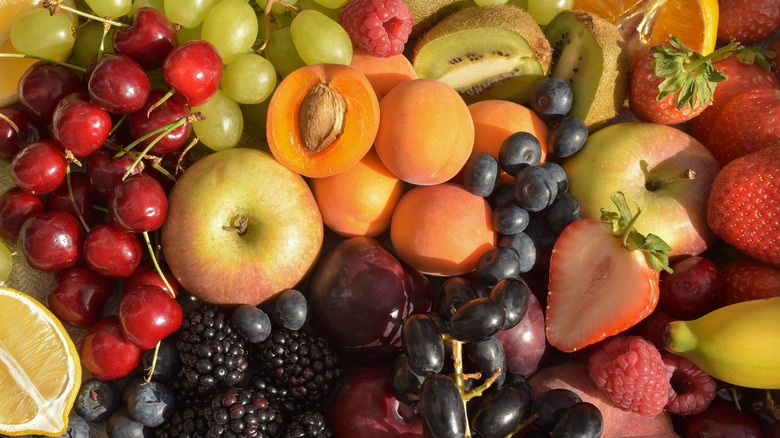The Underrated Fruit That's Perfect To Bake Into Desserts Once It Becomes Overripe
It's tricky to choose a perfect plum every time you visit the grocery store. The sweet, succulent fruits are seasonal from June to September, varying from the bright red Santa Rosa to the deep purple Victoria. This means that it's tricky to tell the quality of a plum based on color or shape alone. Like most fruits, plums have a short shelf life, only lasting about five days in the fridge before turning mushy, soft, wrinkled, and brown. But don't worry if you've spotted these telltale symptoms of an overripe plum; all hope is not lost. At this stage, the fruit actually becomes the perfect ingredient for autumnal baked treats. This is because overripe plums have a higher sugar content than ripe ones, making them incredibly sweet. It's not just their taste, but their soft texture and vivid color that make them a delicious addition to cakes, tarts, and galettes.
Slicing overripe plums into segments and mixing with a healthy dose of cinnamon and sugar makes a delicious inclusion to a buttery sponge cake. You could also stew the fruits into a crumble (don't peel the plums, as the tart skin adds a tasty kick) or even pair them with cottage cheese for a healthier option. Roasting the plums caramelizes their natural sugars, creating a syrupy flavor that makes sweet treats ooze with sticky, caramelized complexity. This actually makes overripe plums a better choice than their perfectly ripe counterparts, so make sure they're part of your next baking session to end up with desserts that impress.
What else can you do with overripe plums?
While you may, at first, be disappointed to find overripe plums in your cupboard, they are actually a very versatile ingredient. Sure -– roasting them is one way to draw out those natural flavors, but they're also ideal for turning into puree. All you have to do is roast the plums in maple syrup, peel off the skin, and blend until smooth. Then, you have a delectable topping for oatmeal, toast, or cheesecake.
Plum puree is more viscous than plum sauce, and tangier than jam, and it's good for you as well, containing plenty of fiber, potassium, antioxidants, and vitamin C. If you have more of a savory tooth, why not experiment with adding the puree to a lamb tagine or dishing it up alongside roasted pork (rather than the more classic pairing of apple sauce). In some instances, you can even use it as a substitute for oil or butter, due to its high moisture content.
The possibilities with overripe plums are endless. Chopped and mixed, they taste great in a chutney; infused in vodka, they create a sour and sweet homemade liquor. You can also mix them with spices for BBQ sauce, or, of course, macerate, mill, and cook them for several jars of jam. When fall rolls around, there's no shortage of ways to use up your overripe plums. You could even whip up an entire plum-themed feast, complete with drinks, savory dishes, and, of course, desserts to finish.

